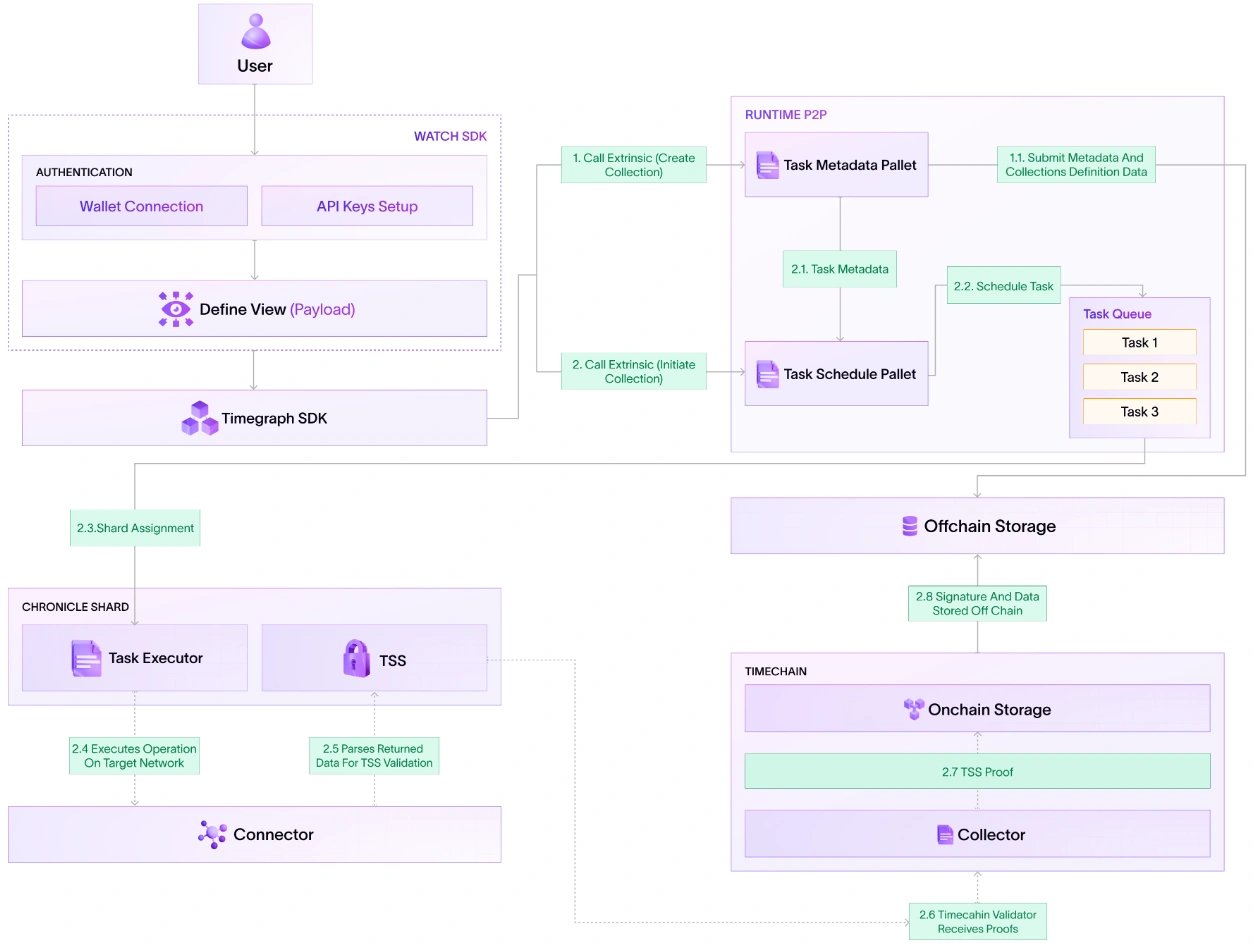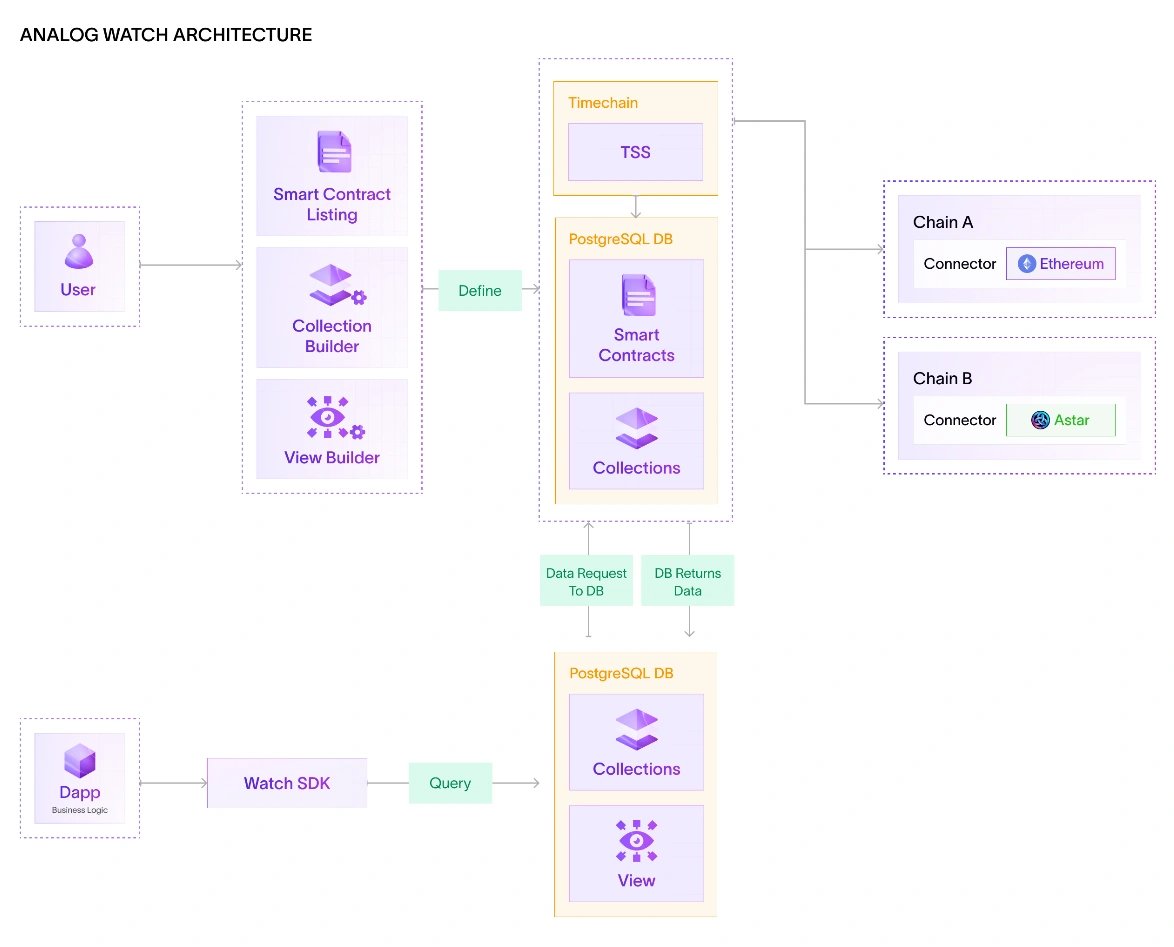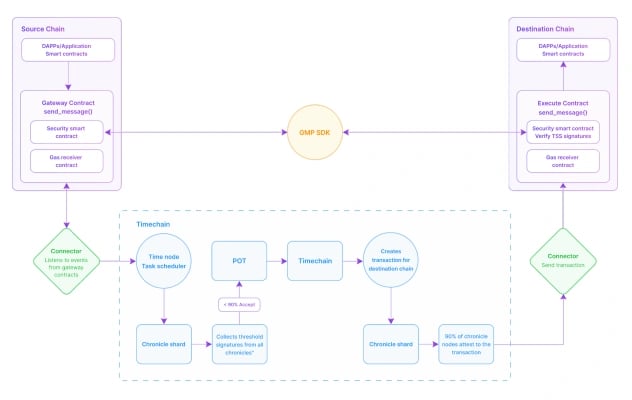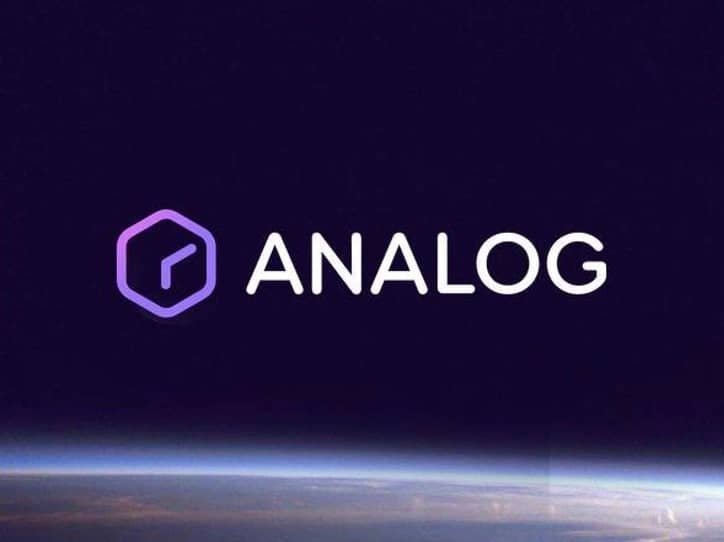Subscribe to wiki
Share wiki
Bookmark
Analog
The Agent Tokenization Platform (ATP):Build autonomous agents with the Agent Development Kit (ADK)
Analog
Analog is an omni-chain interoperability protocol built on top of the Substrate SDK's (Software Development Kits) Nominated Proof-of-Stake (NPoS). This suite revolves around the NPoS-powered ledger called Timechain, offering tools for DApp (Decentralized Application) development and cross-chain communication in the blockchain ecosystem.[1][2]
Overview
Founded in 2021 by Victor Young, Analog is committed to transitioning from traditional consensus algorithms to Proof-of-Time (PoT), with the aim of improving security, transparency, and inclusivity.[3] At its core, Analog is composed of three key components, Timechain, SDKs, and Unified API. The Timechain, a consensus-agnostic protocol, forms the bedrock of the ecosystem. It is maintained by decentralized validators, ensuring the integrity and security of cross-chain transactions. Complementing the Timechain are the SDKs, providing developers with user-friendly, plug-and-play tools. These SDKs connect to the Timechain, facilitating access to blockchain data and enabling cross-chain smart contract execution. Through the use of its Unified API, Analog aims to further streamline development, offering a single, accessible GraphQL endpoint for querying smart contracts across Analog-supported chains.[4][5]
Analog Network monitors and interacts with other interconnected chains using a set of validators known as time nodes. Each time node connects to an off-chain module known as a Chronicle Worker and a Connector. These components continuously scan other chains, transactions, event logs, and state alterations. Whenever a user or application seeks blockchain data from a connected chain, any time node on that chain can promptly relay the event to the Timechain. This triggers a consensus process based on a threshold signature scheme (TSS), demanding a supermajority (comprising over two-thirds of active time nodes) to endorse the transaction before it advances to the Timechain for further validation via the DPoS algorithm.[6]
Moreover, Analog focuses on empowering DApp developers by employing its technology stack which includes developer-friendly Watch UI and SDK, called Analog Watch, a PostgreSQL database, and the accountability mechanisms of Timechain primitives. Developers are also able to add custom cross-chain security policies, ensuring flexibility and adaptability.[7]
Key Components
Nodes
Time Nodes
Chronicle Worker
The Chronicle Worker module implements threshold signature schemes (TSS) off-chain and collaborates with the Timechain Core's runtime. This module collectively maintains accounts on different connected chains.
Connector
Connectors are routine-based modules that allow time node operators to observe external chain states and report changes to the Analog Network. Connectors must run for all blockchains that Analog onboarded, and receive rewards, and transaction fees for their services.
Storage Nodes
Analog Network stores validated event data either in on-chain transactions or, for scalability and confidentiality, in off-chain storage. Storage nodes maintain this off-chain data, ensuring its integrity and availability. Users pay storage fees based on transaction size and storage nodes receive compensation from past event data transactions.
Sentinels
Special nodes on the Analog Network outside the time node network. Sentinels monitor gateway smart contracts and connector signatures for fraudulent activities. If any fraudulent activity is detected, Sentinels can submit evidence (fraud proofs) to the Timechain for verification, potentially leading to punitive measures for the offending time node.
Architectural Components
Threshold Signature Schemes (TSS)
TSS in the Analog Network is an advanced signature scheme, based on the FROST protocol, which streamlines the signing process. It distributes signing power among a group of chronicle workers, requiring a minimum of t + 1 workers to produce a valid signature.
This TSS involves two key components:
- KEYGEN: A distributed key generation process that assigns public verification keys and signing keys to chronicle workers. Together, these keys form the secret key.
- KEYSIGN: A distributed signing algorithm that takes event data from external chains and the private input from chronicle workers to generate signatures.
To enhance scalability, the network divides chronicle workers into shards, each with a maximum of 20 workers. These shards coordinate the validation of transactions.
Key rotation is used to minimize malicious influence, ensuring security. Chronicle workers rotate keys within their shards after each epoch (every 7.2 hours), enhancing network resilience. Slashing mechanisms are in place to penalize non-compliance.
Smart Contracts
- Gateway Smart Contracts: They act as intermediaries between dApps on connected chains and application-specific contracts on Analog Network, enabling cross-chain communication.
- Continuum Smart Contracts: These smart contracts provide a unified interface residing on the Timechain, simplifying dApp development and offering flexibility when interacting with external networks.[6]
Products
Analog Watch
Analog Watch, an integral component of the Analog Network, seeks to improve and simplify data accessibility in Web3. It serves as a full-stack indexing protocol built upon the Timechain infrastructure, offering a decentralized and cryptographically secured solution for indexing data from listed smart contracts.[8][9]
Analog Watch Artifacts
At the center of Analog Watch lie two key artifacts for engaging with blockchain data from supported chains. The first artifact, known as "Collections," acts as a blueprint, guiding Analog Network nodes in the indexing of specific data from smart contracts. These collections are accessible via GraphQL endpoints, where only relevant information from complex inputs is found, streamlining data retrieval. The second key component, "Views," allows for the creation of logic to query data from multiple collections, enhancing data aggregation capabilities.[10][11]

Internal Process
- Authentication and Session Keys: Users commence by undergoing an authentication process that involves connecting their wallet. Once successfully authenticated, they generate session keys (SSKs), serving as digital keys for accessing Analog Watch.
- Creating Collections: Collections act as filters, specifying the particular data from smart contracts that a user is interested in. Users create a collection schema outlining their data preferences.
- Generating a Call Extrinsic: Subsequent to creating a collection schema, Analog Watch undertakes the technical aspects, producing a "Call Extrinsic" comprising instructions for the Timechain network.
- Timechain and Task Scheduler: The Timechain network, comprised of time nodes and various modules, enters the scene. The Task Metadata Pallet handles the storage of metadata associated with the collection off-chain in a PostgreSQL database.
- Task Schedule and Shard: Tasks are scheduled and forwarded to designated shards through the Task Schedule Pallet. Shards represent smaller networks within the Timechain. Task processing follows a "first-come, first-serve" principle.
- Chronicle Workers and Task Execution: Within the selected shard, Chronicle Workers execute the tasks. They interact with external blockchain networks through Connectors.
- Data Aggregation and Signatures: Once data is retrieved from external blockchains, each Chronicle Worker transmits it to a lead Chronicle Worker (Collector) in the shard. The Collector consolidates signatures from multiple Chronicle Workers as part of a secure, multi-party computation process.
- Threshold Signature Scheme (TSS) Proof: In order to ensure data integrity, a requisite number of Chronicle Workers must endorse the retrieved data. When this supermajority is reached, the Collector generates a TSS proof.
- Timechain Consensus: The TSS proof is then submitted to the Timechain, where a consensus mechanism validates its authenticity. This verification process ensures that the data remains untampered with.
- Publication: With the data now verified, it is published to the Timechain. This publication includes metadata and proof, while the actual data and signatures are stored off-chain, combining efficiency and security.
- Interacting with Artifacts: Users are subsequently able to engage with the artifacts they've created. This interaction is facilitated through the utilization of the Watch SDK or Watch UI. These tools offer a straightforward approach to accessing and utilizing processed blockchain data across various applications.[12]
Watch UI
Watch UI, a hosted service, leverages the capabilities of Analog Network to provide users with a platform for publishing and exploring collections and views. This interface simplifies interactions with blockchain data, offering features such as API key generation, deployment of collections and views, and exploration of smart contracts and associated data.[13]
Key Features of Watch UI
- Simplified Functionality: Users can deploy and query collections and views effortlessly, making blockchain data from various supported chains more accessible.
- Robust Infrastructure: Watch UI eliminates the need for users to set up their own servers and manage complex code, providing access to scalable blockchain data.
- Facilitated DApp Deployment: The platform enables the creation of powerful DApps without the complexities of running nodes or managing indexing solutions.
- Comprehensive Access: Watch UI grants users a comprehensive view of published smart contracts, collections, and views through an intuitive interface.[13]
How Watch UI Works
To utilize Watch UI effectively, users are required to connect their wallets and generate API keys, which serve as authentication and authorization mechanisms. Subsequently, they can deploy collections, which act as templates for data retrieval. Deploying views allows for data aggregation from multiple collections, with the underlying process involving the validation of smart contract events, mapping handlers, and data submission to the Timechain for metadata representation.[13]

Watch SDK
The Watch SDK is a toolkit designed to simplify and optimize the deployment and querying of on-chain data from supported chains. Developers can use this toolkit to access and query blockchain data via a unified GraphQL endpoint, overcoming common challenges associated with Web3 data operations.[14]
Key Features of Watch SDK
- Integrated Authentication and Permissions: The Timegraph protocol incorporates Web3 permissions, ensuring data security through wallet authentication and role-based access control (RBAC).
- Unified GraphQL Endpoint: Unlike other Web3 data providers with multiple access endpoints, the Timegraph API offers a single, unified GraphQL endpoint for streamlined data querying across various chains, simplifying the development process.
Timechain
Timechain stands as a ledger powered by the Nominated Proof-of-Stake (NPoS) consensus algorithm which is in the works of being replaced by Proof-of-Time (PoT). The Timechain serves as an accountability layer for published collections or views. Anyone can leverage the stored hashes on the Timechain to provide verifiable evidence of the authenticity and immutability of the queried data. It also embodies several vital responsibilities, including its role as a public and auditable ledger for user interaction with the time node network. It also serves as a foundation for constructing diverse DApps, such as Analog Watch, contributing to enhanced security and governance infrastructure, while enabling the execution of Continuum smart contracts.[15]
Process
When a new block is added to the Timechain, Analog Watch understands what data it needs from the connected chain and how to organize it using collections. If users have complex requirements or need to combine multiple collections, they can create a single entity. This entity can then be queried just like a regular collection. Once a collection is published, its processed data is stored in a PostgreSQL database, ready for users and applications to access through a GraphQL endpoint. Validation and consensus processes at two levels ensure the integrity of blockchain data:[15]
- Threshold Cryptography: A threshold signature schemes (TSS) module, operating in an off-chain mode on each validator (Chronicle Worker), enables nodes to vouch for the authenticity of blockchain data by affixing their signatures. In the event a supermajority of chronicle workers attest to data validity, the lead node, serving as a coordinator node for a specific group of chronicle workers (shard), consolidates the signatures and broadcasts the data as a single payload to the time nodes.
- Timechain Consensus: Time nodes partake in a Byzantine Fault Tolerance (BFT) consensus protocol at the node level, leading to an agreement on the validity of the broadcasted payload. Upon consensus achievement, a hash ID linked to the collection becomes appended to the Timechain. The hash ID operates as a testament or proof of the published collection or view, with the corresponding data for these artifacts residing off-chain. Any individual can generate evidence of stored data and permissions, subsequently posting them to the Timechain to determine data validity and availability.
GMP SDK
At the core of the Analog platform's interoperability lies the Generic Message Passing (GMP) protocol. This protocol operates atop a permissionless network of time nodes, providing routing and validation services. GMP fundamentally transforms the way decentralized applications function within a multi-chain ecosystem. Developers of DApps can utilize the GMP protocol to construct cross-chain applications that require application logic, shared states, and efficient liquidity utilization. With the GMP protocol, users of the Analog Network can benefit from different blockchain ecosystems while using a simplified and single-transaction user experience (UX), eliminating the need for complex manual interactions.[6]
GMP Architecture
The architecture of the GMP protocol is composed of several essential components, encompassing both on-chain and off-chain environments.
On-Chain Components
- Gateway Smart Contracts: These contracts are observed by time nodes (through Chronicle Workers) and are pivotal in facilitating cross-chain communication. The network deploys one smart contract for each connected chain, managed by time nodes.
- Gas Receiver Services (GRS) Smart Contract: Deployed on the source chain, this contract manages the payment of transaction fees, allowing users/applications to pay transactions as a unified bundle in the source chain's native token.
- **Security Smart Contracts: **These contracts verify that cross-chain messages delivered to the destination chain were appropriately signed by the required number of chronicle workers from the source chain. DApp developers can optionally specify the shard, or a subset of nodes, for their applications.
- Time Nodes (Validators): On-chain nodes responsible for voting on proposed blocks to the Timechain, with voting power proportional to the staked $ANLOG tokens. These nodes also relay messages across the network, serving as Byzantine Fault Tolerant (BFT) notaries validating blocks added to the Timechain.
Off-Chain Components
- Time Nodes (Blockchain Oracles): Each time node performs two routines off-chain: Chronicle Worker and Connectors. Chronicle Workers participate in Threshold Signature Schemes (TSS) consensus for state changes in external chains, updating states on connected chains. Connectors fetch validated transactions/data and generate signed payloads transmitted to time nodes for verification.
- Sentinels: Storage nodes, full nodes storing Timechain data, receive compensation from past event data transactions. Users cover transaction costs, including storage fees.
Using GMP
To operationalize the GMP protocol, developers employ gateway smart contracts on both the source and destination chains. Analog Network streamlines this functionality, eliminating the need for manual implementation. Developers can initiate cross-chain applications with ease, benefiting users on any connected chain through straightforward integration.[6]
In a nutshell, the GMP protocol allows an application on the source chain (Chain X) to transmit a message to the destination chain (Chain Y). The process involves user/application interaction with the source chain's gateway smart contract, transaction fee prepayment, conversion of fees, authentication, TSS-based consensus, and validation on the Timechain.[6]

Use Cases
- Cross-chain DEX: Analog GMP facilitates seamless cross-chain trading, enabling users to access liquidity from different blockchains without relying on intermediate tokens or centralized exchanges.
- DeFi Lending and Borrowing Optimization: Analog GMP allows users to utilize assets on one chain as collateral for protocols on other supported blockchains, streamlining the process and optimizing returns without manual intervention.
- Cross-chain Liquidation Protocols: Users can deploy assets across multiple DeFi protocols on various networks through Analog GMP, enhancing liquidity provision and accessibility.
- Cross-chain NFT Marketplaces: Analog GMP enables secure trading of NFTs across different blockchains while maintaining their status and ownership, expanding their utility in various use cases.
- Cross-chain DAOs: Analog GMP facilitates inclusive governance by allowing token holders on different chains to participate in the decision-making processes of DeFi protocols, fostering a diverse framework.
Timegraph SDK
The Timegraph SDK serves as a unifying platform for all blockchain data striving to streamline the process of accessing Web3 data at scale. It offers developer SDKs that are intended to simplify their interactions with the Timechain, facilitate access to blockchain data, and enable the execution of smart contracts across different blockchain networks, fostering interoperability within the ecosystem.[16]
The Timegraph API, made accessible via the Timegraph SDK, introduces a user-friendly solution, granting users and DApp developers straightforward access to data from any connected blockchain through an intuitive interface. In addition to the Timegraph SDK, Analog also provides the Timechain SDK and Connector SDK, essential tools that empower time node operators to maintain the network.[6]
Analog Partners Program
The Analog Partners Program is an initiative designed to identify, support, and mentor cross-chain projects that utilize Timechain as their Layer-0 messaging protocol. By harnessing the liquidity, assets, and user base across various Layer-1 and Layer-2 ecosystems, Analog aims to foster the development of more robust and powerful DApps through cross-chain smart contract calls.
Program Qualifications
Builders interested in developing applications on top of the Timechain are eligible to participate in this program. To qualify, users must have a set of smart contracts or runtimes within either EVM or Substrate ecosystems. Participants do not need to have a specific high-level use case in mind; Analog provides assistance in identifying potential applications. [17]
Core Benefits
Participants in the Analog Launch Partners Program can access a range of benefits tailored to their needs:
- Locked $ANLOG Token Grant: Participants receive a token grant based on specific project milestones, typically ranging from 0.05% to 0.25% of the total token supply per project. Staking incentives are also available for these locked tokens.
- Dedicated Support: Program participants receive dedicated support, including technical assistance, business development guidance, and marketing support.
- Network Access: Participants gain access to Analog's network of Layer-1 and Layer-2 partners actively collaborating on cross-chain projects.
- Investor Connections: The program provides introductions to Analog's extensive network of investors interested in cross-chain opportunities, with over 400 investors currently engaged.
- Co-Marketing Opportunities: Collaboration opportunities for co-marketing exist, including features on Analog's blog, website, Twitter spaces, and other promotional channels.[17]
Analog Grant Program
The Analog Grant Program was established to provide support to promising projects and community contributors, to foster the growth of the Analog ecosystem. This program offers funding, with rewards extending up to 50,000 USD, available in either stablecoins or Analog tokens, and exceptional cases may receive more substantial support.[18]
Grant Types
There are three distinct grant categories under the Analog Grant Program:
- Application Grants: These grants are intended for builders who integrate existing smart contracts and/or runtimes from different blockchain networks using Analog. Additionally, applicants who utilize significant portions of their application code and infrastructure to query data via Analog Watch are eligible for these grants.
- Infrastructure Grants: Builders who undertake the development of essential infrastructure components for the Analog ecosystem are eligible for infrastructure grants. This category encompasses projects related to block explorers, smart contracting systems, new connector integrations, validator maintenance tools, and more.
- Community Grants: Community members who actively contribute to the Analog community and promote Analog's technology through activities such as hackathons, events, and marketing initiatives can apply for community grants.
Award Criteria
The specific grant amount awarded is determined based on the scope and merits of each project. All grants follow a milestone-based structure, with the possibility of multiple milestones within a single grant. Some funding may be allocated before the project commencement, depending on the project's nature, primarily for purposes like human resources or event hosting. However, the majority of funds are disbursed upon successful milestone completion. Each milestone's significance is evaluated, and its weight may vary depending on its nature.
Applications and Selection Process
The grant application and selection process is as follows:
- Submission of Application: Applicants submit their grant proposals.
- Review and Follow-up Conference: For applications requesting 10,000 USD or more, a follow-up conference call may be arranged to discuss grant details. Applications seeking less than 10,000 USD may not require a follow-up call.
- Acceptance and Offer: If the grant application successfully passes the review stage and is accepted, Analog extends a grant offer that includes relevant milestones and completion criteria. Once mutually agreed upon, both parties sign the grant agreement.
- Milestone Evaluation: After the applicant completes the milestones, the Analog team assesses adherence to the grant's terms and allocates funding accordingly.
- Participating in the Analog Grant Program offers builders and community contributors valuable resources to advance their projects and contribute to the Analog ecosystem's development.[18]
See something wrong?
The Agent Tokenization Platform (ATP):Build autonomous agents with the Agent Development Kit (ADK)
